人教版(2019)选择性必修第三册Unit 5 Poems Review Attributive Clause课件(共35张PPT)
文档属性
| 名称 | 人教版(2019)选择性必修第三册Unit 5 Poems Review Attributive Clause课件(共35张PPT) | 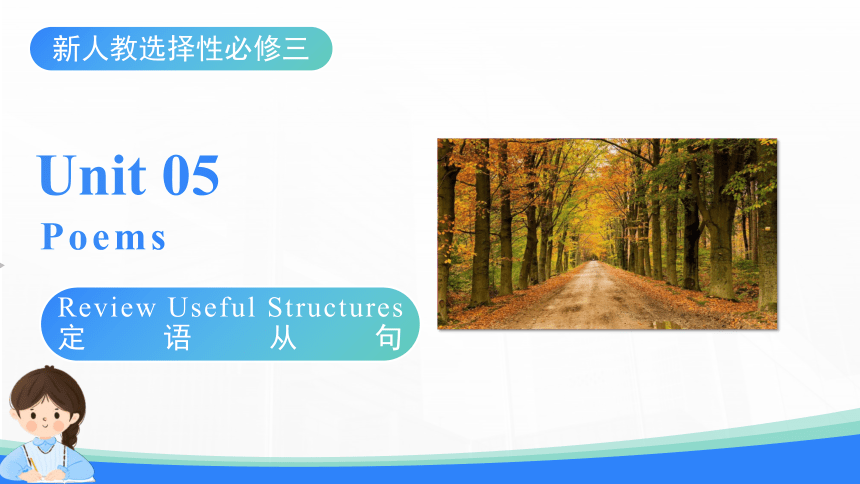 | |
| 格式 | pptx | ||
| 文件大小 | 2.7MB | ||
| 资源类型 | 教案 | ||
| 版本资源 | 人教版(2019) | ||
| 科目 | 英语 | ||
| 更新时间 | 2023-07-23 22:35:30 | ||
图片预览

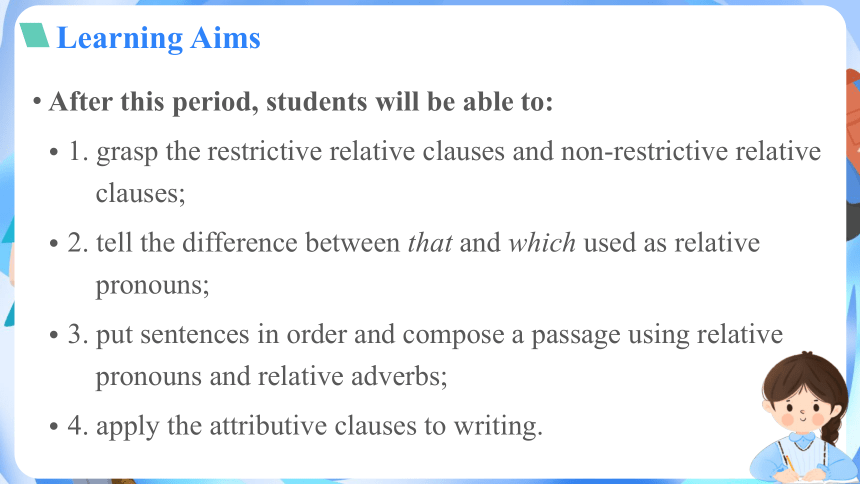
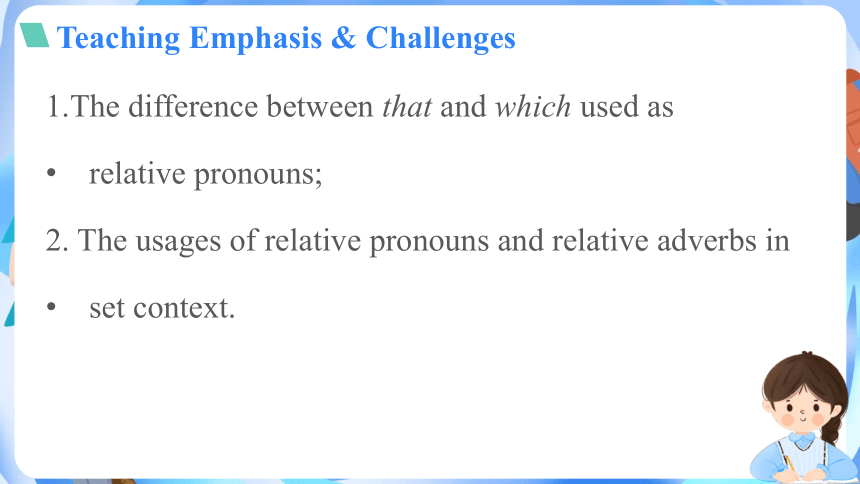
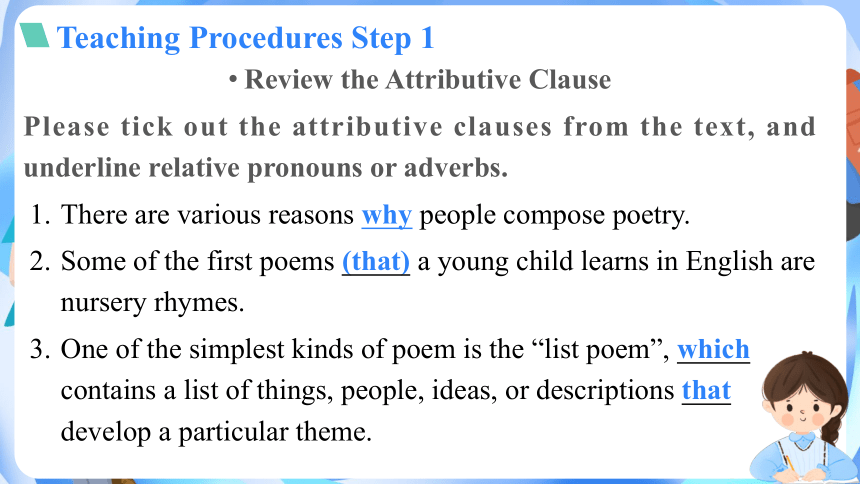

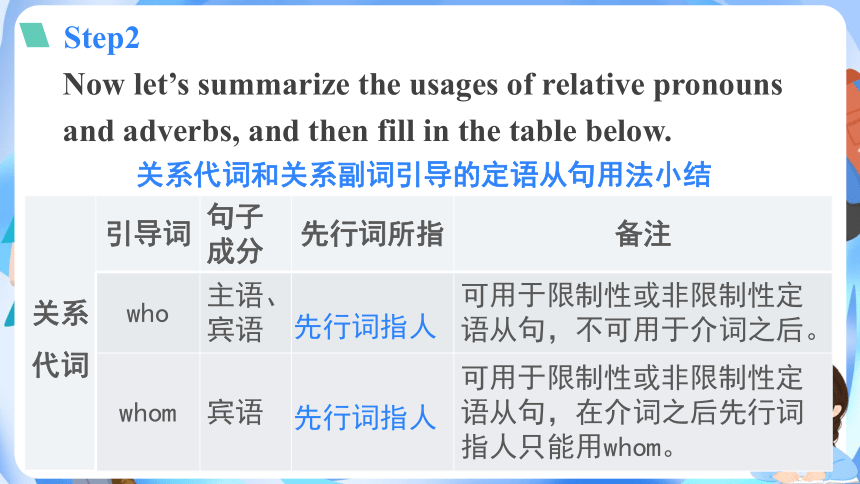
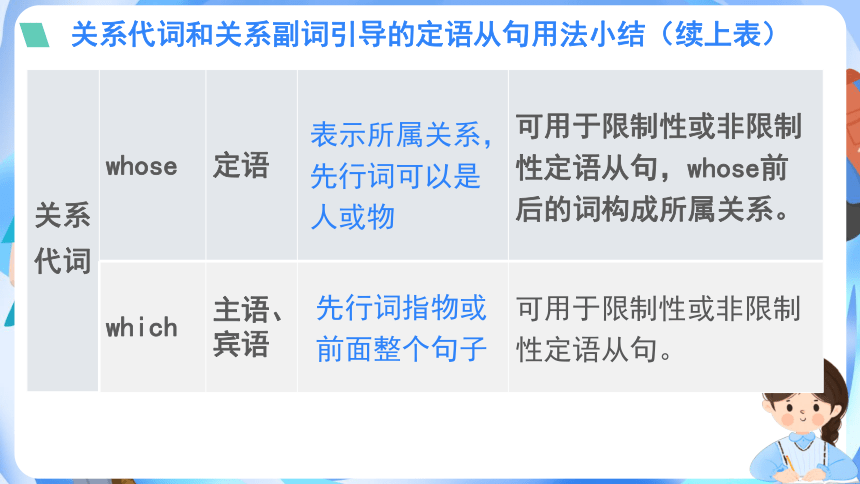
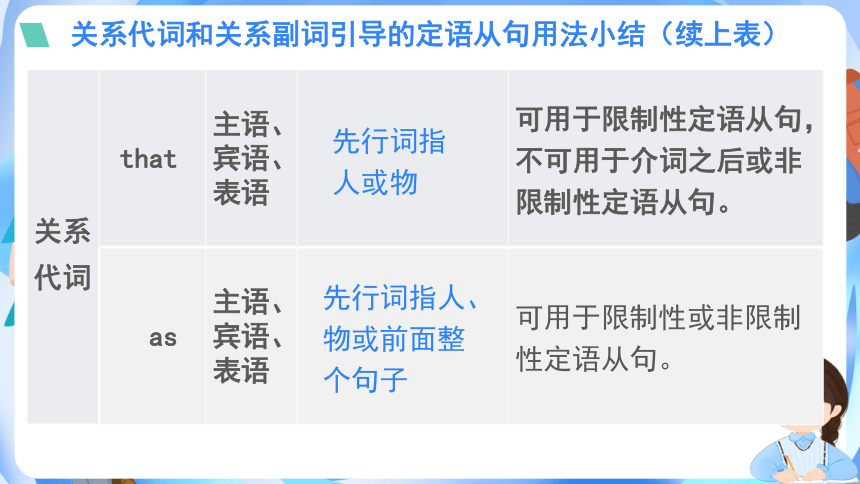

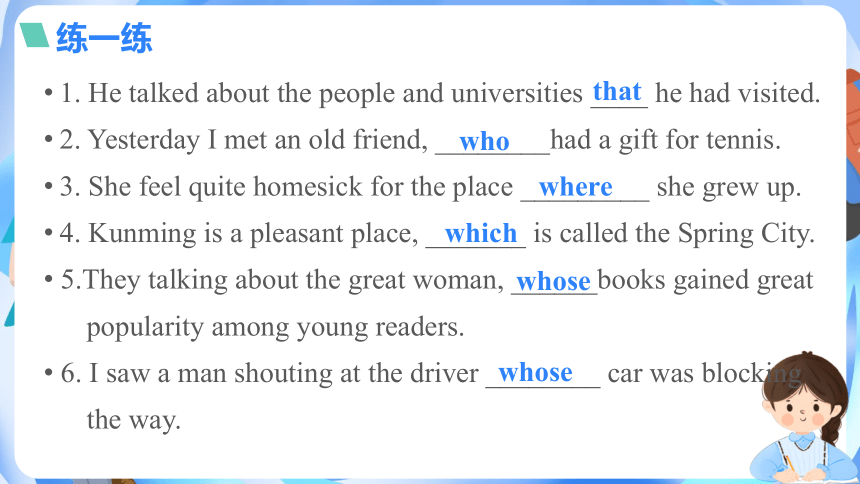
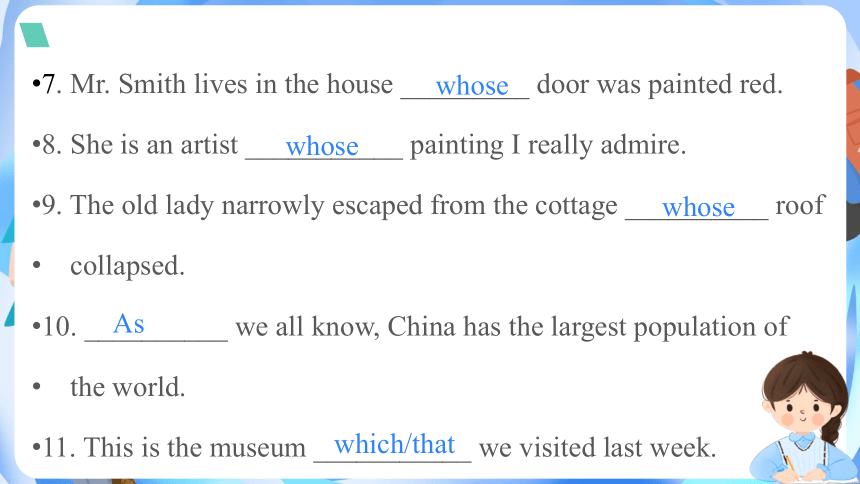
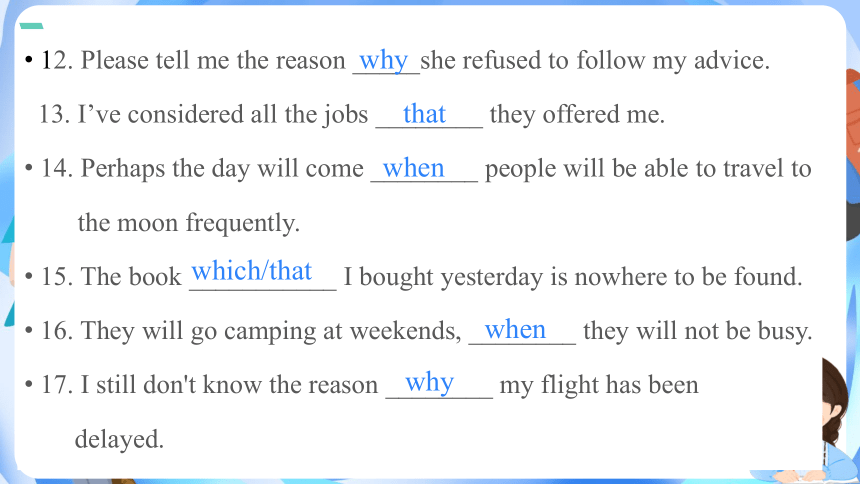
文档简介
(共35张PPT)
Review Useful Structures
定语从句
Unit 05
Poems
新人教选择性必修三
After this period, students will be able to:
1. grasp the restrictive relative clauses and non-restrictive relative clauses;
2. tell the difference between that and which used as relative pronouns;
3. put sentences in order and compose a passage using relative pronouns and relative adverbs;
4. apply the attributive clauses to writing.
Learning Aims
1.The difference between that and which used as
relative pronouns;
2. The usages of relative pronouns and relative adverbs in
set context.
Teaching Emphasis & Challenges
Review the Attributive Clause
Please tick out the attributive clauses from the text, and underline relative pronouns or adverbs.
There are various reasons why people compose poetry.
Some of the first poems (that) a young child learns in English are nursery rhymes.
One of the simplest kinds of poem is the “list poem”, which contains a list of things, people, ideas, or descriptions that develop a particular theme.
Teaching Procedures Step 1
List poems have a flexible line length and repeated phrases which give both a pattern and a rhythm to the poem.
Another simple form of poem that amateurs can easily write is the cinquain, which is made up five lines.
Haiku is a Japanese form of poetry that consists of 17 syllables respectively.
The haiku poem on the right is a translation from Japanese, which shows a moment in the life of delicate butterfly.
关系代词和关系副词引导的定语从句用法小结
关系代词 引导词 句子 成分 先行词所指 备注
who 主语、宾语 可用于限制性或非限制性定语从句,不可用于介词之后。
whom 宾语 可用于限制性或非限制性定语从句,在介词之后先行词指人只能用whom。
先行词指人
先行词指人
Step2
Now let’s summarize the usages of relative pronouns and adverbs, and then fill in the table below.
关系代词和关系副词引导的定语从句用法小结(续上表)
关系 代词 whose 定语 可用于限制性或非限制性定语从句,whose前后的词构成所属关系。
which 主语、宾语 可用于限制性或非限制性定语从句。
表示所属关系,先行词可以是人或物
先行词指物或前面整个句子
关系代词和关系副词引导的定语从句用法小结(续上表)
关系 代词 that 主语、宾语、表语 可用于限制性定语从句,不可用于介词之后或非限制性定语从句。
as 主语、宾语、表语 可用于限制性或非限制性定语从句。
先行词指人或物
先行词指人、物或前面整个句子
关系 副词 when 时间状语 先行词为 ________ 可用on which替代
where 地点状语 先行词为 ________ 可用in which替代
why 原因状语 先行词为 ________ 可用for which替代
时间
地点
reason
关系代词和关系副词引导的定语从句用法小结(续上表)
1. He talked about the people and universities ____ he had visited.
2. Yesterday I met an old friend, ________had a gift for tennis.
3. She feel quite homesick for the place _________ she grew up.
4. Kunming is a pleasant place, _______ is called the Spring City.
5.They talking about the great woman, ______books gained great
popularity among young readers.
6. I saw a man shouting at the driver ________ car was blocking
the way.
that
who
where
which
whose
whose
练一练
7. Mr. Smith lives in the house _________ door was painted red.
8. She is an artist ___________ painting I really admire.
9. The old lady narrowly escaped from the cottage __________ roof
collapsed.
10. __________ we all know, China has the largest population of
the world.
11. This is the museum ___________ we visited last week.
whose
whose
whose
As
which/that
12. Please tell me the reason _____she refused to follow my advice.
13. I’ve considered all the jobs ________ they offered me.
14. Perhaps the day will come ________ people will be able to travel to
the moon frequently.
15. The book ___________ I bought yesterday is nowhere to be found.
16. They will go camping at weekends, ________ they will not be busy.
17. I still don't know the reason ________ my flight has been
delayed.
why
that
when
which/that
when
why
18. We have decided to buy the house ________windows face the sea.
19. This is the town ___________ his grandfather used to work.
20. The place ___________ we visited was the Summer Palace.
whose
where
which/that
1、遇到以下情况只能用who,不能用that。
(1)在非限制性定语从句中;
(2)当先行词是one,ones,anyone,those并且指人时,
只能用who;
(3)当先行词是人称代词时,只能用who。
He who does not reach the Great Wall is not a true man.
He who would search for pearls must dive below.
Step 3
Tell the differences between who and that, which and that, which and as, and relative pronouns and adverbs.
2.在下列情况下,关系词用that而不用which。
(1) 当先行词是anything,everything,nothing(something除外),few,all,none,little等代词时,或者是由any,every,all,some,no,little,few,much,each等修饰时;
Sir, is there anything that I can do for you
(2) 当先行词被序数词修饰时;
Visiting his brother was the last thing that he would consider.
(3) 当先行词被形容词最高级修饰时;
This is the best film that I have seen in years.
(4) 当先行词被the very/only/same/last 修饰时;
This is the very thing that she needs.
(5) 当先行词前有which或who作为疑问代词为了避免重复时;
Who is the boy that is being questioned by the policeman
(6) 当先行词既有人,又有物时。
They talked about the things and people that they remembered
at school.
3.只用which而不用that引导的定语从句
(1) 非限制性定语从句只用which而不能用that。
Some of the roads collapsed, which made our travel more difficult. 非限制性定语从句
The novel that/which I have just read was written by Liu Cixin. 限制性定语从句
2) 跟在介词后,只用which,whom而不用that。
This is the place in which my father used to work.
4.which与as的区别
(1)在限制性定语从句中,当先行词由such,the same或so修饰时,关系代词要用as
(2)在非限制性定语从句中,which引导的从句一般在主句之后,而as引导的从句,可在主句之前或者主句之后。
(3)在非限制性定语从句中,which通常意为“这;这一点”;as通常表示说话人的态度、看法、解释等,意为“正如;就像”。
(4) 在限制性定语从句中,当先行词由such,the same或so修饰时,关系代词要用as
This is the same book as I bought the other day.
He looks the same as he did at school.
_____ is often the case, Grandpa talked about his good old days.
______ can be seen, oceans cover more than 70% of the earth.
He failed in the exam again, ___________ came as a surprise.
As
As
which
5. 关系代词和关系副词的差别
定语从句中,如果缺少主语或宾语,则用关系代词(that/which);
如果不缺主语或宾语而缺状语,则用关系副词(when/where/why)。
抽象的地点名词case,situation,point,scene,activity,stage,spot等,在从句中作状语时,用where引导; 作主语或宾语时,用that/which。
Step 4 Exercises
练一练
请用正确的关系词填空:
1. We visited a factory _________ is located to the south of the city.
2. We visited a factory _________ clothes are made for women.
3. I hope I never live to see the day _______ computers finally replace books.
4. I’ll never forget the day ___________ we spent together.
5. What’s the reason ___________ drives her to leave the company
6. This is the reason ___________ he explained at the meeting.
which/that
where
when
which/that
which/that
which/that
7. I’d like to know the reason _______ you are late.
8. You could get into a situation __________ you have to
decide immediately.
9. Are you facing a situation ____________ looks impossible to fix
10. He pointed to the spot ___________ the house used to stand.
11. The spot ___________ I like most is the wooden house in
the forest.
why
where
which/that
where
which/that
Step 5 Practice (Textbook Page 53)
Practice: Connect the sentences using relative pronouns or adverbs .Then put the sentences in the correct order to compose a passage.
The Crescent Moon is perhaps the most famous collection of children’s poems. It is known to people in China.
There are also many poems written from a child’s perspective. In these poems the poet Tagore shows a sympathetic understanding of children’s feelings.
The English version of the book contains nearly 50 poems.
The focus of the poems is on the parent-child relationship.
The initial poems were written from the perspective of a mother. The mother loves her baby at play and at rest, in laughter and in tears.
Many people love to read this collection of poems. The reason is that they can feel the warmth of love and enjoy the innocence of childhood.
It was written by the Indian poet Tagore. Tagore was the first Asian to win the Nobel Prize in Literature.
1.The Crescent Moon is perhaps the most famous collection of children’s poems that is known to people in China.
2.The reason why many people love to read this collection of poems is that they can feel the warmth of love and enjoy the innocence of childhood.
3.The English version of the book contains nearly 50 poems, the focus of which is on the parent-child relationship.
Suggested Answers:
4.The initial poems were written from the perspective of a mother who/that loves her baby at play and at rest, in laughter and in tears.
5. It was written by the Indian poet Tagore who/that was the first Asian to win the Nobel Prize in Literature.
6.There are also many poems written from a child’s perspective in which the poet Tagore shows a sympathetic understanding of children’s feelings.
Step 6 Practice
Read the following introduction about the Brownings. Help the author edit the passage to make it more concise, using relative clauses if necessary.
If you study the history of English literature, you will find the names of Robert and Elizabeth Barrett Browning. They were one of the most romantic literary couples of the Victorian era. Elizabeth Barrett started to write poetry from about the age of six. In 1844,Elizabeth’s Poems brought her great success. It also attracted the admiration of poet Robert Browning. Browning fell in love with her poetry and then they entered into personal correspondence.
The couple exchanged many letters. The letters obviously helped sow the seeds of love between the two.
Elizabeth had been ill for many years. She stayed at home and almost never saw visitors. Browning was sure about his love, so he found a way to visit her, and immediately convinced her to become his bride. However, their subsequent marriage was carried out in secret. It was because Barrett’s father was a dominant and selfish man.
He would refuse to let his daughter go. The couple moved to Italy in 1846.Elizabeth lived there for the rest of her life. Browning had a great influence on Elizabeth’s writing. The best evidence that can be found is Sonnets from the Portuguese. The sonnets were written during the time when she was in love with Robert Browning.
A Possible Version
If you study the history of English literature, you will find the names of Robert and Elizabeth Barrett Browning who/that were one of the most romantic literary couples of the Victorian era. Elizabeth Barrett started to write poetry from about the age of six. In 1844, Elizabeth’s Poems brought her great success and attracted the admiration of poet Robert Browning. Browning fell in love with her poetry and then they entered into personal correspondence.
The couple exchanged many letters which/that obviously helped sow the seeds of love between the two. Elizabeth had been ill for many years. She stayed at home and almost never saw visitors. Browning was sure about his love, so he found a way to visit her, and immediately convinced her to become his bride. However, their subsequent marriage was carried out in secret because Barrett’s father was a dominant and selfish man who/that would refuse to let his daughter go.
The couple moved to Italy in 1846 where Elizabeth lived for the rest of her life. Browning had a great influence on Elizabeth’s writing. The best evidence that can be found is Sonnets from the Portuguese that were written during the time when she was in love with Robert Browning.
Step7 Pair work
Work in pairs. Describe your favorite Chinese poets using sentences that contain relative clauses and then exchange your works with your partners and polish them to make them more concise.
Suggested answers:
Bai Juyi was one of the greatest Chinese poets who ever lived. He was born during the mid-Tang Dynasty, which was a period of rebuilding and recovery for the Tang Empire.
He is best known for his poem Song of Everlasting Sorrow (《长恨歌》) which was an instant success when he published it in 806 CE and remains so today. The poem is a romanticized version of the real-life affair of Xuanzong and Lady Yang which is still required reading in school. Bai Juyi is known for his highly romantic poetry which uses vivid but also very simple imagery because he wanted everyone to be able to enjoy his work without having to struggle to find its meaning.
Thanks for watching
谢谢观看
Review Useful Structures
定语从句
Unit 05
Poems
新人教选择性必修三
After this period, students will be able to:
1. grasp the restrictive relative clauses and non-restrictive relative clauses;
2. tell the difference between that and which used as relative pronouns;
3. put sentences in order and compose a passage using relative pronouns and relative adverbs;
4. apply the attributive clauses to writing.
Learning Aims
1.The difference between that and which used as
relative pronouns;
2. The usages of relative pronouns and relative adverbs in
set context.
Teaching Emphasis & Challenges
Review the Attributive Clause
Please tick out the attributive clauses from the text, and underline relative pronouns or adverbs.
There are various reasons why people compose poetry.
Some of the first poems (that) a young child learns in English are nursery rhymes.
One of the simplest kinds of poem is the “list poem”, which contains a list of things, people, ideas, or descriptions that develop a particular theme.
Teaching Procedures Step 1
List poems have a flexible line length and repeated phrases which give both a pattern and a rhythm to the poem.
Another simple form of poem that amateurs can easily write is the cinquain, which is made up five lines.
Haiku is a Japanese form of poetry that consists of 17 syllables respectively.
The haiku poem on the right is a translation from Japanese, which shows a moment in the life of delicate butterfly.
关系代词和关系副词引导的定语从句用法小结
关系代词 引导词 句子 成分 先行词所指 备注
who 主语、宾语 可用于限制性或非限制性定语从句,不可用于介词之后。
whom 宾语 可用于限制性或非限制性定语从句,在介词之后先行词指人只能用whom。
先行词指人
先行词指人
Step2
Now let’s summarize the usages of relative pronouns and adverbs, and then fill in the table below.
关系代词和关系副词引导的定语从句用法小结(续上表)
关系 代词 whose 定语 可用于限制性或非限制性定语从句,whose前后的词构成所属关系。
which 主语、宾语 可用于限制性或非限制性定语从句。
表示所属关系,先行词可以是人或物
先行词指物或前面整个句子
关系代词和关系副词引导的定语从句用法小结(续上表)
关系 代词 that 主语、宾语、表语 可用于限制性定语从句,不可用于介词之后或非限制性定语从句。
as 主语、宾语、表语 可用于限制性或非限制性定语从句。
先行词指人或物
先行词指人、物或前面整个句子
关系 副词 when 时间状语 先行词为 ________ 可用on which替代
where 地点状语 先行词为 ________ 可用in which替代
why 原因状语 先行词为 ________ 可用for which替代
时间
地点
reason
关系代词和关系副词引导的定语从句用法小结(续上表)
1. He talked about the people and universities ____ he had visited.
2. Yesterday I met an old friend, ________had a gift for tennis.
3. She feel quite homesick for the place _________ she grew up.
4. Kunming is a pleasant place, _______ is called the Spring City.
5.They talking about the great woman, ______books gained great
popularity among young readers.
6. I saw a man shouting at the driver ________ car was blocking
the way.
that
who
where
which
whose
whose
练一练
7. Mr. Smith lives in the house _________ door was painted red.
8. She is an artist ___________ painting I really admire.
9. The old lady narrowly escaped from the cottage __________ roof
collapsed.
10. __________ we all know, China has the largest population of
the world.
11. This is the museum ___________ we visited last week.
whose
whose
whose
As
which/that
12. Please tell me the reason _____she refused to follow my advice.
13. I’ve considered all the jobs ________ they offered me.
14. Perhaps the day will come ________ people will be able to travel to
the moon frequently.
15. The book ___________ I bought yesterday is nowhere to be found.
16. They will go camping at weekends, ________ they will not be busy.
17. I still don't know the reason ________ my flight has been
delayed.
why
that
when
which/that
when
why
18. We have decided to buy the house ________windows face the sea.
19. This is the town ___________ his grandfather used to work.
20. The place ___________ we visited was the Summer Palace.
whose
where
which/that
1、遇到以下情况只能用who,不能用that。
(1)在非限制性定语从句中;
(2)当先行词是one,ones,anyone,those并且指人时,
只能用who;
(3)当先行词是人称代词时,只能用who。
He who does not reach the Great Wall is not a true man.
He who would search for pearls must dive below.
Step 3
Tell the differences between who and that, which and that, which and as, and relative pronouns and adverbs.
2.在下列情况下,关系词用that而不用which。
(1) 当先行词是anything,everything,nothing(something除外),few,all,none,little等代词时,或者是由any,every,all,some,no,little,few,much,each等修饰时;
Sir, is there anything that I can do for you
(2) 当先行词被序数词修饰时;
Visiting his brother was the last thing that he would consider.
(3) 当先行词被形容词最高级修饰时;
This is the best film that I have seen in years.
(4) 当先行词被the very/only/same/last 修饰时;
This is the very thing that she needs.
(5) 当先行词前有which或who作为疑问代词为了避免重复时;
Who is the boy that is being questioned by the policeman
(6) 当先行词既有人,又有物时。
They talked about the things and people that they remembered
at school.
3.只用which而不用that引导的定语从句
(1) 非限制性定语从句只用which而不能用that。
Some of the roads collapsed, which made our travel more difficult. 非限制性定语从句
The novel that/which I have just read was written by Liu Cixin. 限制性定语从句
2) 跟在介词后,只用which,whom而不用that。
This is the place in which my father used to work.
4.which与as的区别
(1)在限制性定语从句中,当先行词由such,the same或so修饰时,关系代词要用as
(2)在非限制性定语从句中,which引导的从句一般在主句之后,而as引导的从句,可在主句之前或者主句之后。
(3)在非限制性定语从句中,which通常意为“这;这一点”;as通常表示说话人的态度、看法、解释等,意为“正如;就像”。
(4) 在限制性定语从句中,当先行词由such,the same或so修饰时,关系代词要用as
This is the same book as I bought the other day.
He looks the same as he did at school.
_____ is often the case, Grandpa talked about his good old days.
______ can be seen, oceans cover more than 70% of the earth.
He failed in the exam again, ___________ came as a surprise.
As
As
which
5. 关系代词和关系副词的差别
定语从句中,如果缺少主语或宾语,则用关系代词(that/which);
如果不缺主语或宾语而缺状语,则用关系副词(when/where/why)。
抽象的地点名词case,situation,point,scene,activity,stage,spot等,在从句中作状语时,用where引导; 作主语或宾语时,用that/which。
Step 4 Exercises
练一练
请用正确的关系词填空:
1. We visited a factory _________ is located to the south of the city.
2. We visited a factory _________ clothes are made for women.
3. I hope I never live to see the day _______ computers finally replace books.
4. I’ll never forget the day ___________ we spent together.
5. What’s the reason ___________ drives her to leave the company
6. This is the reason ___________ he explained at the meeting.
which/that
where
when
which/that
which/that
which/that
7. I’d like to know the reason _______ you are late.
8. You could get into a situation __________ you have to
decide immediately.
9. Are you facing a situation ____________ looks impossible to fix
10. He pointed to the spot ___________ the house used to stand.
11. The spot ___________ I like most is the wooden house in
the forest.
why
where
which/that
where
which/that
Step 5 Practice (Textbook Page 53)
Practice: Connect the sentences using relative pronouns or adverbs .Then put the sentences in the correct order to compose a passage.
The Crescent Moon is perhaps the most famous collection of children’s poems. It is known to people in China.
There are also many poems written from a child’s perspective. In these poems the poet Tagore shows a sympathetic understanding of children’s feelings.
The English version of the book contains nearly 50 poems.
The focus of the poems is on the parent-child relationship.
The initial poems were written from the perspective of a mother. The mother loves her baby at play and at rest, in laughter and in tears.
Many people love to read this collection of poems. The reason is that they can feel the warmth of love and enjoy the innocence of childhood.
It was written by the Indian poet Tagore. Tagore was the first Asian to win the Nobel Prize in Literature.
1.The Crescent Moon is perhaps the most famous collection of children’s poems that is known to people in China.
2.The reason why many people love to read this collection of poems is that they can feel the warmth of love and enjoy the innocence of childhood.
3.The English version of the book contains nearly 50 poems, the focus of which is on the parent-child relationship.
Suggested Answers:
4.The initial poems were written from the perspective of a mother who/that loves her baby at play and at rest, in laughter and in tears.
5. It was written by the Indian poet Tagore who/that was the first Asian to win the Nobel Prize in Literature.
6.There are also many poems written from a child’s perspective in which the poet Tagore shows a sympathetic understanding of children’s feelings.
Step 6 Practice
Read the following introduction about the Brownings. Help the author edit the passage to make it more concise, using relative clauses if necessary.
If you study the history of English literature, you will find the names of Robert and Elizabeth Barrett Browning. They were one of the most romantic literary couples of the Victorian era. Elizabeth Barrett started to write poetry from about the age of six. In 1844,Elizabeth’s Poems brought her great success. It also attracted the admiration of poet Robert Browning. Browning fell in love with her poetry and then they entered into personal correspondence.
The couple exchanged many letters. The letters obviously helped sow the seeds of love between the two.
Elizabeth had been ill for many years. She stayed at home and almost never saw visitors. Browning was sure about his love, so he found a way to visit her, and immediately convinced her to become his bride. However, their subsequent marriage was carried out in secret. It was because Barrett’s father was a dominant and selfish man.
He would refuse to let his daughter go. The couple moved to Italy in 1846.Elizabeth lived there for the rest of her life. Browning had a great influence on Elizabeth’s writing. The best evidence that can be found is Sonnets from the Portuguese. The sonnets were written during the time when she was in love with Robert Browning.
A Possible Version
If you study the history of English literature, you will find the names of Robert and Elizabeth Barrett Browning who/that were one of the most romantic literary couples of the Victorian era. Elizabeth Barrett started to write poetry from about the age of six. In 1844, Elizabeth’s Poems brought her great success and attracted the admiration of poet Robert Browning. Browning fell in love with her poetry and then they entered into personal correspondence.
The couple exchanged many letters which/that obviously helped sow the seeds of love between the two. Elizabeth had been ill for many years. She stayed at home and almost never saw visitors. Browning was sure about his love, so he found a way to visit her, and immediately convinced her to become his bride. However, their subsequent marriage was carried out in secret because Barrett’s father was a dominant and selfish man who/that would refuse to let his daughter go.
The couple moved to Italy in 1846 where Elizabeth lived for the rest of her life. Browning had a great influence on Elizabeth’s writing. The best evidence that can be found is Sonnets from the Portuguese that were written during the time when she was in love with Robert Browning.
Step7 Pair work
Work in pairs. Describe your favorite Chinese poets using sentences that contain relative clauses and then exchange your works with your partners and polish them to make them more concise.
Suggested answers:
Bai Juyi was one of the greatest Chinese poets who ever lived. He was born during the mid-Tang Dynasty, which was a period of rebuilding and recovery for the Tang Empire.
He is best known for his poem Song of Everlasting Sorrow (《长恨歌》) which was an instant success when he published it in 806 CE and remains so today. The poem is a romanticized version of the real-life affair of Xuanzong and Lady Yang which is still required reading in school. Bai Juyi is known for his highly romantic poetry which uses vivid but also very simple imagery because he wanted everyone to be able to enjoy his work without having to struggle to find its meaning.
Thanks for watching
谢谢观看
